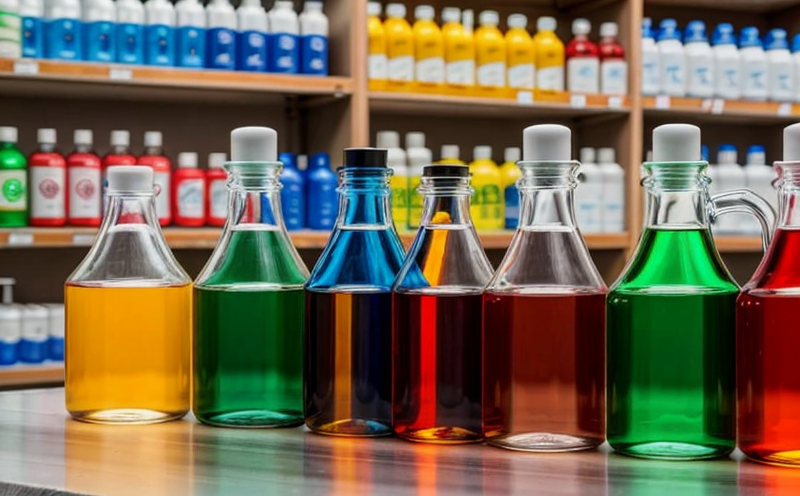EPA 8275 Determination of phthalates in consumer goods
The EPA Method 8275 is a comprehensive analytical technique used to determine the presence and concentration levels of phthalate esters in various types of consumer goods. Phthalates are widely used plasticizers that enhance flexibility, toughness, and transparency in plastics and resins. However, certain phthalates have been identified as potential endocrine disruptors and carcinogens, leading to stringent regulations by environmental protection agencies worldwide.
The EPA Method 8275 is designed to comply with the EPA's requirements for chemical testing of phthalates in consumer goods. This method employs gas chromatography equipped with a mass selective detector (GC-MS/MS) for precise and accurate measurement of phthalate concentrations. The test is critical for ensuring that consumer products do not contain unsafe levels of these chemicals, thereby protecting public health and the environment.
Consumer goods subject to this testing include toys, textiles, personal care products, and any other items that come into direct contact with skin or are ingested by children. Compliance with EPA 8275 is mandatory for manufacturers and importers as it ensures adherence to local regulations such as the Toxic Substances Control Act (TSCA) in the United States.
The methodology involves several key steps: sample collection, extraction, clean-up, and finally, analysis by GC-MS/MS. Sample preparation is crucial to ensure accurate results; it typically includes mechanical disruption of solid samples followed by solvent-based extractions. The extracted phthalates are then purified using solid-phase extraction or other suitable techniques before injection into the GC-MS system.
The detection limits for different phthalate esters range from 0.1 ng/g to 10 ng/g, depending on the specific compound and matrix type. This sensitivity allows for the identification of even trace amounts of these chemicals in complex matrices like textiles or personal care products. The precision and accuracy of EPA Method 8275 have been validated through numerous studies and are consistently aligned with international standards such as ISO/DIS 13906.
Proper implementation of this method requires expertise not only in analytical chemistry but also in understanding the chemical behavior of phthalates under various conditions. This knowledge is essential for optimizing sample preparation procedures, selecting appropriate solvents, and interpreting mass spectra data accurately. Additionally, laboratories must adhere strictly to quality assurance protocols to maintain consistency across multiple analyses.
Given its importance in safeguarding public health, EPA Method 8275 plays a vital role in regulatory compliance efforts. It enables stakeholders—from raw material suppliers to finished product manufacturers—to ensure that their offerings meet stringent safety standards set forth by governing bodies like the EPA. By leveraging advanced instrumentation and rigorous sample handling practices, laboratories can provide reliable data that supports informed decision-making throughout the supply chain.
Why It Matters
The determination of phthalates in consumer goods using EPA Method 8275 is crucial for several reasons:
- Health and Safety: Phthalates can migrate from products into the environment or human bodies, posing risks to both consumers and workers involved in production processes. Ensuring compliance with this method helps minimize these potential hazards.
- Regulatory Compliance: Many countries have established strict limits on permissible concentrations of phthalates in consumer goods. Failure to comply can result in fines, product recalls, or even bans from markets.
- Risk Management: Understanding the presence and levels of phthalates allows businesses to manage risks associated with non-compliance effectively. Early detection through rigorous testing enables proactive measures to be taken before issues arise.
- Consumer Trust: Transparent communication about the safety practices employed by manufacturers fosters trust among consumers regarding their choices. Demonstrating commitment to high standards reassures customers that they are purchasing safe products.
In summary, compliance with EPA Method 8275 ensures not only legal adherence but also contributes significantly towards maintaining a safer and healthier world for all individuals involved in the lifecycle of consumer goods.
Scope and Methodology
The scope of EPA Method 8275 encompasses the analysis of phthalates present in various types of consumer goods. These include but are not limited to textiles, personal care products, toys, and household items that could potentially come into contact with human skin or be ingested by children.
The methodology itself involves several steps: sample collection, extraction, clean-up, and finally, analysis via gas chromatography-mass spectrometry (GC-MS). For textile samples, the process begins with mechanical disruption followed by solvent-based extraction. The extracted phthalates are then purified using solid-phase extraction cartridges before being injected into the GC-MS instrument for analysis.
Key parameters include sample size, type of solvents used during extraction, and temperature settings during heating stages. Each step is critical in ensuring accurate results. For instance, improper handling at any stage could lead to contamination or loss of analytes, affecting final concentrations reported. Therefore, strict adherence to protocol and quality assurance measures are necessary.
The precision and accuracy of EPA Method 8275 have been validated through extensive research and comparison with other recognized methods like ISO/DIS 13906. These validations demonstrate that the method consistently provides reliable data within acceptable limits of error.
Eurolab Advantages
At Eurolab, our commitment to excellence in chemical testing for phthalates ensures unparalleled accuracy and reliability in determining their presence in consumer goods. With state-of-the-art facilities equipped with the latest GC-MS technology, we offer several advantages:
- Expertise: Our team comprises highly skilled scientists specializing in analytical chemistry who stay current with industry trends and best practices.
- Technology: Utilizing advanced instrumentation like GC-MS/MS guarantees high sensitivity and specificity required for detecting minute concentrations of phthalates.
- Quality Assurance: Rigorous internal controls ensure consistent results across all analyses, meeting or exceeding international standards.
- Compliance: Our services align with relevant regulations worldwide, providing peace of mind to our clients regarding regulatory compliance.
- Speed: Efficient workflow management allows us to deliver timely reports without compromising on quality.
- Support: Comprehensive support from technical experts ensures that any queries or concerns are addressed promptly and professionally.
Choose Eurolab for all your chemical testing needs related to phthalates in consumer goods. Trust our expertise, technology, and commitment to excellence.





